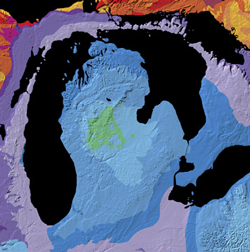
21.12.08
18.12.08
17.12.08
16.12.08
last stand

The most ancient and least disturbed forest ecosystem in eastern North America clings to the vertical cliffs of the Niagara Escarpment. Prior to 1988 it had escaped detection even though the entire forest was in plain view and was being visited by thousands upon thousands of people every year. The reason no one had discovered the forest was that the trees were relatively small and lived on the vertical cliffs of the Niagara Escarpment. The Last Stand reveals the complete account of the discovery of this ancient forest, of the miraculous properties of the trees forming this forest (eastern white cedar), and of what is was like for researchers to live, work and study within this forest. The unique story is told with text, with stunning colour photographs and through vivid first-hand accounts. This book will stand the test of time as a testament to science, imagination and discovery.
15.12.08
peninsula watersheds

The east-west tilt of the Peninsula results in a general
flow of waters toward Lake Huron. Some of this drainage
occurs beneath the surface in underground channels
and rivers that have cut their way through the
soft porous rock. On the surface, the northern Bruce
is dotted with wetlands and lakes and has a history of
rich inland fisheries.
Within [Bruce Peninsula National Park], surface waters
move northeast to southwest. A complex of inland
lakes, including Emmett, Crane, George, Umbrella,
and Upper and Lower Andrew, are found in the north
central portion of the Park; some occupy basins carved
by glacial action from the bedrock. In addition to the
surface flow, there is some underground drainage
through caves and fissures in the bedrock. The park
area also has several different types of beaches: sand,
cobble, and boulder.
14.12.08
traditional territories of Saugeen Ojibway Nations


Map is based on the traditional knowledge of the elders of the Saugeen Ojibway Nations and current research. It shows the territory and treaty areas of the Saugeen Ojibway peoples, who have inhabited the Bruce Peninsula and areas to the south of it for thousands of years. Sauking Neyashing translated means “homeland of the Saugeen Nations, this beautiful land partially surrounded by water.” As well as current reserve lands, the Saugeen Ojibway Nations (composed of the Chippewas of Nawash Unceded First Nation and the Saugeen Ojibway Unceded First Nation) share a hunting ground known as Nitaagekamiing, which is bounded on three sides by the national park. The First Nations collectively launched a land claim in 1994 for part of their traditional territories, claiming breach of trust by the Canadian government in meeting its obligation to protect Aboriginal lands. The claim seeks return of lands that remain unsold and financial compensation for the loss of use of the peninsula.
Areas of Natural and Scientific Interest of the Northern Bruce Peninsula

The Ontario Ministry of Natural Resources designates
ANSIs that recognize either distinctive “life science”
features, such as rare species or ecosystems, or
“earth science” features, such as unusual or unique
geological formations. ANSI designation is often
supported by a detailed inventory of the species and
special characteristics of the area, but the designation
itself provides no protection from development
or resource harvesting within the area. The Bruce
County Official Plan recognizes that ANSIs should be
managed as special natural environments and that
development, if it occurs, should be planned to avoid
undermining the ANSIs natural values. However, the
plan also recognizes the County has limited means to
control or permanently protect these special areas.
Protected areas of the Northern Bruce Peninsula

Bruce Peninsula National Park is the largest, but not
the only, fully protected area on the northern Bruce
Peninsula. There are five provincial parks and nature
reserves within the greater park ecosystem of Bruce
Peninsula National Park as well as a handful of private
nature reserves and Fathom Five National Marine Park
(which includes a number of islands and a small mainland
area) . This diversity of protected areas reflects
the high degree of biological diversity and the number
of rare and unusual species and ecosystems found on
the Bruce. But protected areas on their own cannot
protect species and ecosystems. Species may have
home ranges that are much larger than any one protected
area or rare species may be found in areas that
are not protected. This is why scientists are increasingly
calling for the establishment of landscape linkages
between different protected areas and for stewardship
of private lands.
9.12.08
5.12.08
Subscribe to:
Comments (Atom)
































































